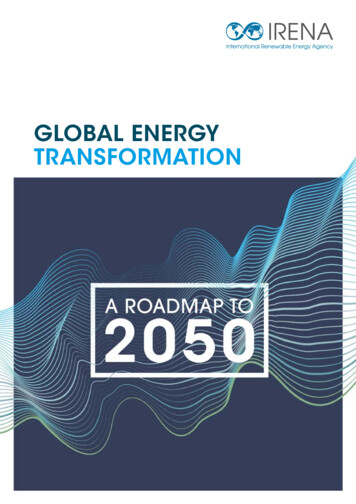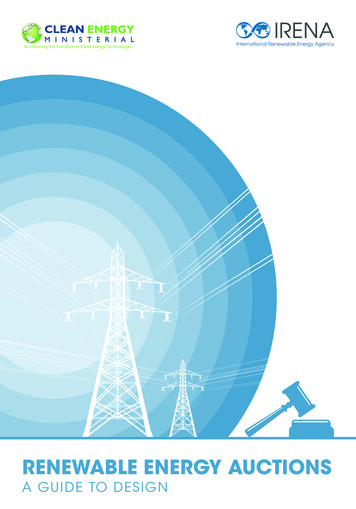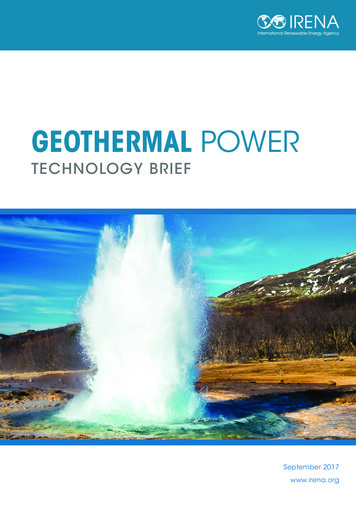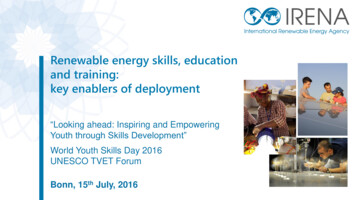
Transcription
GLOBAL ENERGYTRANSFORMATION
IRENA 2018Unless otherwise stated, material in this publication may be freely used, shared, copied, reproduced, printed and/or stored, provided that appropriate acknowledgement is given of IRENAas the source and copyright holder. Material in this publication that is attributed to third partiesmay be subject to separate terms of use and restrictions, and appropriate permissions fromthese third parties may need to be secured before any use of such material.ISBN 978-92-9260-059-4About IRENAThe International Renewable Energy Agency (IRENA) is an intergovernmental organisation that supports countries in theirtransition to a sustainable energy future, and serves as the principal platform for international co-operation, a centre ofexcellence, and a repository of policy, technology, resource and financial knowledge on renewable energy. IRENA promotes the widespread adoption and sustainable use of all forms of renewable energy, including bioenergy, geothermal,hydropower, ocean, solar and wind energy in the pursuit of sustainable development, energy access, energy security andlow-carbon economic growth and prosperity. www.irena.orgAcknowledgementsValuable external review was provided by Martha Ekkert & Martin Schöpe (BMWi), Morgan Bazilian (Colorado School ofMines), Kim Møller Porst (EFKM), Luiz Barroso & Rafael de Sá Ferreira (EPE), Wang Zhongying (ERI), Andreas Kraemer(IASS), Laura Cozzi, Paolo Frankl, Timur Gul & Andrew Prag (IEA), Doug Arent & Jeff Logan (NREL), Mauricio Tolmasquim(PPE), and Ben King & Paul Spitsen (US DOE).The authors would like to extend a special thanks to Deger Saygin (SHURA Energy Transition Centre).Valuable review and feedback was provided by IRENA colleagues Ahmed Abdel-Latif, Yong Chen, Bowen Hong, Paul Komor,Divyam Nagpal, Thomas Nikolakakis, Asami Miketa, Elizabeth Press, Hameed Safiullah, Emanuele Talbi, Michael Taylor, andHenning Wuester. The editor of this report was Robert Archer.Consultants for REmap who assisted in preparation of this report include Toby Couture, David Jacobs and Owen Zinaman.The macro-economic modelling (E3ME) results were provided by Hector Pollitt, Jon Stenning, Eva Alexandri, Stijn VanHummelen, Unnada Chewpreecha, and other team members of Cambridge Econometrics, UK.Contributing authors: This report was prepared by the REmap team at IRENA’s Innovation and Technology Centre (IITC)and Policy Team at IRENA’s Knowledge, Policy and Finance Centre (KPFC). The REmap analysis and sections were authoredby Dolf Gielen, Ricardo Gorini, Nicholas Wagner, Rodrigo Leme, Laura Gutierrez & Gayathri Prakash, with additionalcontributions and support by Paul Durrant, Luis Janeiro & Jennifer Winter. The socio-economic analysis and sections wereauthored by Xavier Casals, Bishal Parajuli, Michael Renner, Sandra Lozo, Arslan Khalid, Álvaro López-Peña and Rabia Ferroukhi.IRENA is grateful for the generous support of the Federal Ministry for Economic Affairs and Energy of Germany, which madethe publication of this report a reality.Report citationIRENA (2018), Global Energy Transformation: A roadmap to 2050, International Renewable Energy Agency, Abu Dhabi.This report is available for download from www.irena.org/publications. For further information or to provide feedback,please contact IRENA at info@irena.orgDisclaimerThis publication and the material herein are provided “as is”. All reasonable precautions have been taken by IRENA toverify the reliability of the material in this publication. However, neither IRENA nor any of its officials, agents, data or otherthird-party content providers provides a warranty of any kind, either expressed or implied, and they accept no responsibility or liability for any consequence of use of the publication or material herein.The information contained herein does not necessarily represent the views of the Members of IRENA. The mention ofspecific companies or certain projects or products does not imply that they are endorsed or recommended by IRENAin preference to others of a similar nature that are not mentioned. The designations employed and the presentation ofmaterial herein do not imply the expression of any opinion on the part of IRENA concerning the legal status of any region,country, territory, city or area or of its authorities, or concerning the delimitation of frontiers or boundaries.2
F O R E WO R DForewordIn an era of accelerating change, the imperative to limit climate change and achieve sustainablegrowth is strengthening the momentum of the global energy transformation. The rapid declinein renewable energy costs, improving energy efficiency, widespread electrification, increasingly“smart” technologies, continual technological breakthroughs and well-informed policy makingall drive this shift, bringing a sustainable energy future within reach.While the transformation is gaining momentum, it must happen faster. Around two-thirds ofglobal greenhouse gas emissions stem from energy production and use, which are at the coreof efforts to combat climate change. To meet climate goals, progress in the power sector needsto accelerate further, while the decarbonisation of transport and heating must pick up steam.As this report makes clear, current and planned policies offer a comparatively slow path,whereby the world would exhaust its energy-related “carbon budget” in under 20 years, interms of efforts to keep the global temperate rise well below 2 C. The budget for a 1.5 C limit,meanwhile, would potentially run out in less than a decade.The energy system, consequently, requires rapid, immediate and sustained change. Thedeployment of renewables must increase at least six-fold compared to the levels set out incurrent plans. The share of electricity in total energy use must double, with substantialelectrification of transport and heat. Renewables would then make up two-thirds of energyconsumption and 85% of power generation. Together with energy efficiency, this could deliverover 90% of the climate mitigation needed to maintain a 2 C limit.Adnan Z. AminDirector-General, IRENAFortunately, this is also the path of opportunity. It would enable faster growth, create more jobs,create cleaner cities and improve overall welfare. In economic terms, reducing human healthand environmental costs would bring annual savings by 2050 up to five times the additionalannual cost of the transition. The global economy in 2050 would be larger, with nearly 40 millionjobs directly related to renewables and efficiency. Timely action would also avoid stranding overUSD 11 trillion worth of energy-infrastructure assets that are tied to today’s polluting energytechnologies.Along with analysing options, this report examines the socio-economic footprint of the shiftto renewables, providing insights into how to optimise the outcome. Policies to promote a justand fair transition can maximise the benefits for different countries, regions and communities.Transforming the global energy system would permit affordable, and universal, energy access,increase energy security, and diversify energy supply.The world’s actions today will be crucial to create a sustainable energy system. Ultimately, thepath to secure a better future depends on pursuing a positive, inclusive, economically, sociallyand environmentally beneficial energy transformation.A Renewable Energy Roadmap3
4
CO NTE NT SExecutive Summary. . . . . . . . . . . . . . . . . . . . . . . . . . . . . . . . . . . . . . . . . . . . . . . . . . . . . . . . . . . . . . . . . . . . . . . . .08Introduction. . . . . . . . . . . . . . . . . . . . . . . . . . . . . . . . . . . . . . . . . . . . . . . . . . . . . . . . . . . . . . . . . . . . . . . . . . . . . . . . . . . . 16Status of the energy transition: A mixed picture. . . . . . . . . . . . . . . . . . . . . . . . . . . . . . . . . . . . . . . . . . . . . . . . . 18Energy-related carbon dioxide emissions: Bridging the gap . . . . . . . . . . . . . . . . . . . . . . . . . . . . . . . . . . . . . 21A pathway for the transformation of the global energy system. . . . . . . . . . . . . . . . . . . . . . . . . . . . . . . . . 23Country ambition for the energy transition. . . . . . . . . . . . . . . . . . . . . . . . . . . . . . . . . . . . . . . . . . . . . . . . . . . . . 28Analysis and insights in key sectors. . . . . . . . . . . . . . . . . . . . . . . . . . . . . . . . . . . . . . . . . . . . . . . . . . . . . . . . . . . . . 31Transport . . . . . . . . . . . . . . . . . . . . . . . . . . . . . . . . . . . . . . . . . . . . . . . . . . . . . . . . . . . . . . . . . . . . . . . . . . . . . . . . 31Buildings. . . . . . . . . . . . . . . . . . . . . . . . . . . . . . . . . . . . . . . . . . . . . . . . . . . . . . . . . . . . . . . . . . . . . . . . . . . . . . . . 33Industry . . . . . . . . . . . . . . . . . . . . . . . . . . . . . . . . . . . . . . . . . . . . . . . . . . . . . . . . . . . . . . . . . . . . . . . . . . . . . . . . 36Power . . . . . . . . . . . . . . . . . . . . . . . . . . . . . . . . . . . . . . . . . . . . . . . . . . . . . . . . . . . . . . . . . . . . . . . . . . . . . . . . . . 38Costs, investments and reduced externalities of the energy transition . . . . . . . . . . . . . . . . . . . . . . . . . 41Socio-economic benefits of the energy transition. . . . . . . . . . . . . . . . . . . . . . . . . . . . . . . . . . . . . . . . . . . . . . 44Global GDP. . . . . . . . . . . . . . . . . . . . . . . . . . . . . . . . . . . . . . . . . . . . . . . . . . . . . . . . . . . . . . . . . . . . . . . . . . . . . . 47Employment in the global economy. . . . . . . . . . . . . . . . . . . . . . . . . . . . . . . . . . . . . . . . . . . . . . . . . . . . . . . . 49Global energy sector employment . . . . . . . . . . . . . . . . . . . . . . . . . . . . . . . . . . . . . . . . . . . . . . . . . . . . . . . . . . 51Global welfare. . . . . . . . . . . . . . . . . . . . . . . . . . . . . . . . . . . . . . . . . . . . . . . . . . . . . . . . . . . . . . . . . . . . . . . . . . . 54Regional GDP, employment, welfare. . . . . . . . . . . . . . . . . . . . . . . . . . . . . . . . . . . . . . . . . . . . . . . . . . . . . . . . 57How finance affects the energy transition. . . . . . . . . . . . . . . . . . . . . . . . . . . . . . . . . . . . . . . . . . . . . . . . . . . 62Key socio-economic messages . . . . . . . . . . . . . . . . . . . . . . . . . . . . . . . . . . . . . . . . . . . . . . . . . . . . . . . . . . . . 65How to foster the global energy transformation: Key focus areas. . . . . . . . . . . . . . . . . . . . . . . . . . . . . . . 68Focus Area 1. Tap into the strong synergies between energy efficiency and renewable energy. . . . 69Focus Area 2. Plan a power sector for which renewables provide a high share of the energy . . . . . . 70Focus Area 3. Increase use of electricity in transport, building and industry. . . . . . . . . . . . . . . . . . . . . 70Focus Area 4. Foster system-wide innovation. . . . . . . . . . . . . . . . . . . . . . . . . . . . . . . . . . . . . . . . . . . . . . . . 71Focus Area 5. Align socio-economic structures and investment with the transition. . . . . . . . . . . . . . . 71Focus Area 6. Ensure that transition costs and benefits are fairly distributed. . . . . . . . . . . . . . . . . . . . 72References . . . . . . . . . . . . . . . . . . . . . . . . . . . . . . . . . . . . . . . . . . . . . . . . . . . . . . . . . . . . . . . . . . . . . . . . . . . . . . . . . . . . 745
FI GU R ESFigure 1.In under 20 years the global energy-related CO 2 emissionsbudget to keep warming below 2 C would be exhausted . . . . . . . . . . . . . . . . . . . . . . . . . . . . 21Figure 2.Renewable energy and energy efficiency can provide over 90%of the reduction in energy-related CO 2 emissions . . . . . . . . . . . . . . . . . . . . . . . . . . . . . . . . . . . 22Figure 3.The global share of renewable energy would need to increase totwo-thirds and TPES would need to remain flat over the period to 2050 . . . . . . . . . . . . 23Figure 4. The rising importance of electricity derived from renewable energy. . . . . . . . . . . . . . . . . 24Figure 5.Significant improvements in energy intensity are needed andthe share of renewable energy must rise. . . . . . . . . . . . . . . . . . . . . . . . . . . . . . . . . . . . . . . . . . . . 25Figure 6. Renewable energy should be scaled up to meet power, heat and transport needs. . . . . 26Figure 7.The declining importance of fossil fuels. . . . . . . . . . . . . . . . . . . . . . . . . . . . . . . . . . . . . . . . . . . . . 27Figure 8. A rapid and significant decline in energy-related CO 2 emissionsis necessary in all countries. . . . . . . . . . . . . . . . . . . . . . . . . . . . . . . . . . . . . . . . . . . . . . . . . . . . . . . . . 29Figure 9. Transforming energy demand in the transport sector . . . . . . . . . . . . . . . . . . . . . . . . . . . . . . . . 31Figure 10. Infographic transport . . . . . . . . . . . . . . . . . . . . . . . . . . . . . . . . . . . . . . . . . . . . . . . . . . . . . . . . . . . . . . 32Figure 11. The increasing use of electricity in buildings and the decline of fossil fuels. . . . . . . . . . . 34Figure 12. Infographic buildings. . . . . . . . . . . . . . . . . . . . . . . . . . . . . . . . . . . . . . . . . . . . . . . . . . . . . . . . . . . . . . . 35Figure 13. A diverse energy mix with sizable bioenergy demand. . . . . . . . . . . . . . . . . . . . . . . . . . . . . . . 36Figure 14. Infographic industry. . . . . . . . . . . . . . . . . . . . . . . . . . . . . . . . . . . . . . . . . . . . . . . . . . . . . . . . . . . . . . . . 37Figure 15. The rising importance of solar and wind energy in the power sector. . . . . . . . . . . . . . . . . 39Figure 16. Infographic power. . . . . . . . . . . . . . . . . . . . . . . . . . . . . . . . . . . . . . . . . . . . . . . . . . . . . . . . . . . . . . . . . . 40Figure 17. Investment will need to shift to renewable energy and energy efficiency. . . . . . . . . . . . . 41Figure 18. Reduced externalities far outweigh the costs of the energy transition. . . . . . . . . . . . . . . 42Figure 19. Obtaining the socio-economic footprint from a given combination of an energytransition roadmap and a socio-economic system structure and outlook. . . . . . . . . . . . 44Figure 20. The energy transition results in GDP growth higher than the Reference Casebetween 2018 and 2050. . . . . . . . . . . . . . . . . . . . . . . . . . . . . . . . . . . . . . . . . . . . . . . . . . . . . . . . . . . . 47Figure 21. The energy transition results in employment growth higher thanthe Reference Case between 2018 and 2050. . . . . . . . . . . . . . . . . . . . . . . . . . . . . . . . . . . . . . . . 49Figure 22. The energy transition would generate over 11 million additional energysector jobs by 2050 . . . . . . . . . . . . . . . . . . . . . . . . . . . . . . . . . . . . . . . . . . . . . . . . . . . . . . . . . . . . . . . . 52Figure 23. The energy transition would generate 14 million additional jobs in renewableenergy by 2050 . . . . . . . . . . . . . . . . . . . . . . . . . . . . . . . . . . . . . . . . . . . . . . . . . . . . . . . . . . . . . . . . . . . . 53Figure 24. Components of the welfare indicator used in this analysis. . . . . . . . . . . . . . . . . . . . . . . . . . . 54Figure 25. The energy transition generates significant increases in global welfare. . . . . . . . . . . . . . 55Figure 26. Impact of the energy transition on GDP. . . . . . . . . . . . . . . . . . . . . . . . . . . . . . . . . . . . . . . . . . . . . 57Figure 27. Impact of the energy transition on welfare. . . . . . . . . . . . . . . . . . . . . . . . . . . . . . . . . . . . . . . . . . 58Figure 28. Impact of the energy transition on employment . . . . . . . . . . . . . . . . . . . . . . . . . . . . . . . . . . . . 58Figure 29. Crowding out of capital does affect employment, but the energy transitionstill generates positive employment growth. . . . . . . . . . . . . . . . . . . . . . . . . . . . . . . . . . . . . . . . . 64Figure 30. Planning for the energy transition. . . . . . . . . . . . . . . . . . . . . . . . . . . . . . . . . . . . . . . . . . . . . . . . . . . 686
TAB LESAB B R E VIATI O N STable 1. Key indicators relevant to theenergy transition in selected countries(REmap Case). . . . . . . . . . . . . . . . . . . . . . . . . . . . . . . . . . . . . 30 CCCSCHPCO 2CPICSPEJEUEVG20GDPGHGGtGWGWthICTBOXESBOX 1 - This report and its focus . . . . . . . . . . . . . . . . . . . . . . . . . . . . . . . . . . 18BOX 2 - Energy access and the transition. . . . . . . . . . . . . . . . . . . . . . . 45BOX 3 - Addressing fossil fuel export dependencyand other transition challenges. . . . . . . . . . . . . . . . . . . . . . . . . . 61degrees Celsiuscarbon capture and storagecombined heat and powercarbon dioxideClimate Policy Instituteconcentrated solar powerexajouleEuropean Unionelectric vehicleGroup of Twentygross domestic productgreenhouse gasgigatongigawattgigawatt thermalinformation andcommunicating technologiesIEAInternational Energy Agencyincl.includingIRENA International RenewableEnergy AgencykmkilometrekWhkilowatt-hourLBNLLawrence Berkeley National Laboratorym2square metrem3metre cubedMJmegajoulesN/Anot applicableNDCsNationally DeterminedContributionsOPECOrganization of the PetroleumExporting CountriesPJpetajoulePVphotovoltaicR&Dresearch and developmentRD&D research, development, anddemonstrationREmap renewable energy roadmapSDGSustainable Development GoalsSE4ALL Sustainable Energy for AllT&Dtransmission and distributionTFECtotal final energy consumptionTPEStotal primary energy supplyTWhterawatt-hourUNthe United NationsUSAUnited States of AmericaUSDUnited States DollarVREvariable renewable energyyryear7
EXECUTIVE SUMMARYEXECUTIVE SUMMARYRenewable energy needs to be scaled up at least sixtimes faster for the world to start to meet the goalsset out in the Paris Agreement.The historic climate accord from 2015 seeks, at minimum, to limit average global temperaturerise to “well below 2 C” in the present century, compared to pre-industrial levels. Renewables, incombination with rapidly improving energy efficiency, form the cornerstone of a viable climatesolution.Keeping the global temperature rise below 2 degrees Celsius ( C) is technically feasible.It would also be more economically, socially and environmentally beneficial than the pathresulting from current plans and policies. However, the global energy system must undergo aprofound transformation, from one largely based on fossil fuels to one that enhances efficiencyand is based on renewable energy. Such a global energy transformation – seen as the culminationof the “energy transition” that is already happening in many countries – can create a world that ismore prosperous and inclusive.Currently, emission trends are not on track to meet that goal. Government plans still fall farshort of emission reduction needs. Under current and planned policies, the world would exhaust itsenergy-related “carbon budget” (CO 2) in under 20 years to keep the global temperate rise to wellbelow 2 C (with 66% probability), while fossil fuels such as oil, natural gas and coal would continueto dominate the global energy mix for decades to come.To meet the below 2 C goal, immediate action will be crucial. Cumulative emissions must atleast be reduced by a further 470 gigatons (Gt) by 2050 compared to current and planned policies(business-as-usual) to meet that goal.8
EXECUTIVE SUMMARYFigure ES1. In under 20 years, the global energy-related CO2 emissions budget to keep warmingbelow 2 C would be exhaustedCumulative energy-related CO2 emissions and emissions gap, 2015-2050 (Gt CO2)Cumulative energy-related carbon emissions (Gt CO2)1 500Reference Case: 2.6 C – 3.0 CCumulative CO2 by 2050: 1 230 GtAnnual CO2 in 2050: 34.8 Gt/yr1 2009002037:CO2 budgetexceededReductions in REmap Casecompared to Reference CaseCumulative by 2050: -470 GtAnnual in 2050: -25.1 Gt/yrEnergy-related CO2 budget66% 2 C 2015-2100: 790 GtREmap Case: 66% 2 CCumulative CO2 by 2050: 760 GtAnnual CO2 in 2050: 9.7 Gt/yr60050% 1.5 CEnergy sector CO2 budget:2015 - 2100: 300-450 GtNet annual CO2 emissionsin 2050: 0 Gt/yr300020152020202520302035204020452050Energy efficiency and renewable energy are the main pillars of the energy transition. Whiledifferent paths can mitigate climate change, renewable energy and energy efficiency providethe optimal pathway to deliver the majority of the emission cuts needed at the necessary speed.Together they can provide over 90% of the energy-related CO 2 emission reductions that arerequired, using technologies that are safe, reliable, affordable and widely available.Renewable energy and energy efficiency need to expand in all sectors. The total share ofrenewable energy must rise from around 15% of the total primary energy supply (TPES) in 2015 toaround two-thirds by 2050. To meet climate targets, the energy intensity of the global economywill need to fall by about two-thirds by 2050, lowering the total primary energy supply in that yearto slightly less than 2015 levels. This can be achieved, despite significant population and economicgrowth, by substantially improving energy efficiency.By 2050, all countries can substantially increase the proportion of renewable energy in theirtotal energy use. REmap, a global roadmap prepared by the International Renewable EnergyAgency (IRENA), suggests that renewables can make up 60% or more of many countries’ total finalenergy consumption (TFEC). For instance, China could increase the share of renewable energy inits energy use from 7% in 2015 to 67% in 2050. In the European Union (EU), the share could growfrom about 17% to over 70%. India and the United States could see shares increase to two-thirdsor more.9
EXECUTIVE SUMMARYA decarbonised power sector, dominated by renewable sources, is at the core of the transitionto a sustainable energy future. The share of renewable energy in the power sector would increasefrom 25% in 2017 to 85% by 2050, mostly through growth in solar and wind power generation.This transformation would require new approaches to power system planning, system andmarket operations, and regulation and public policy. As low-carbon electricity becomes the mainenergy carrier, the share of electricity consumed in end-use sectors would need to double fromapproximately 20% in 2015 to 40% in 2050. Electric vehicles (EVs) and heat pumps would becomemore common in most parts of the world. In terms of final energy, renewable electricity wouldprovide just under 60% of total renewable energy use, two and a half times its contribution tooverall renewable energy consumption today.The power sector has made significant progress in recent years, but the speed of progressmust be accelerated. In 2017 the power sector added 167 gigawatts (GW) of renewable energycapacity globally, a robust growth of 8.3% over the previous year and a continuation of previousgrowth rates since 2010 averaging 8% per year. Renewable power generation accounted for anestimated quarter of total global power generation, a new record. New records were also set forsolar and wind installation, with additions of 94 GW in solar photovoltaic (PV) and 47 GW windpower, including 4 GW of offshore wind power. Renewable power generation costs continue to fall.There is ample evidence that power systems dominated by renewables can be a reality, so the scaleand speed of renewable energy deployment can be accelerated with confidence.Industry, transport and the building sectors will need to use more renewable energy. In thesesectors, renewable sources including increased renewable electricity supply, but also solar thermal,geothermal energy and bioenergy, must play important roles. Renewable electricity will play anincreasingly important role but a large contribution are renewable fuels and direct-uses that areneeded for heat and transport. For these the use of biomass could provide a little under two-thirdsof renewable energy used for heat and fuel; solar thermal could provide around one-quarter; andgeothermal and other renewable sources the remainder.Energy efficiency is critical in the building sector. However, the slow rate at which energyefficiency in the sector is improving, due in part to the low building renovation rates of just 1% peryear of existing building stock, remains a major issue. A three-fold increase in this renovation rateis necessary. In industry, the high energy demand of certain industries, the high carbon content ofcertain products, and high emission processes, require novel solutions and lifecycle thinking.10
EXECUTIVE SUMMARYFigure ES2. Significant improvements in energy intensity are needed and the share ofrenewable energy must rise to two-thirdsEnergy intensity improvement rate (%/yr) and renewable energy share in TFEC (%),Reference and REmap cases, 2015-2050Energy intensity improvements (%/yr)Renewables share in TFEC on topercentagerenewables share inTFEC by sector401.3%30200.5065%7018%25%TransportIndustry eCase2050REmapCaseThe global energy transformation makes economic sense. The additional costs of thecomprehensive, long-term energy transition would amount to USD (United States Dollars) 1.7trillion annually in 2050. However, cost-savings from reduced air pollution, better health and lowerenvironmental damage would far outweigh these costs. The REmap Case suggests that savingsin these three areas alone would average USD 6 trillion annually by 2050. In addition, the energytransition would significantly improve the energy system’s global socio-economic footprintcompared with business-as-usual, improving global welfare, GDP (Gross Domestic Product)and employment. Across the world economy, GDP increases by 2050 in both the reference andtransition scenarios. The energy transition stimulates economic activity additional to the growththat could be expected under a business as usual approach. The cumulative gain through increasedGDP from 2018 until 2050 would amount to USD 52 trillionSubstantial additional investment in low-carbon technologies will be required compared tocurrent and planned policies. Cumulative investment in the energy system between 2015 and 2050will need to increase around 30%, from USD 93 trillion according tocurrent and planned policies, to USD 120 trillion to enable the energytransition. Investment in renewable energy and energy efficiencywould absorb the bulk of total energy investments. Also included inthis total is USD 18 trillion that would need to be invested in powergrids and energy flexibility – a doubling over current and plannedpolicies. In total, throughout the period, the global economy wouldneed to invest around 2% of the average global GDP per year indecarbonisation solutions, including renewable energy, energyefficiency, and other enabling technologies.11
EXECUTIVE SUMMARYUnderstanding the socioeconomic footprint of the energy transition is essential to optimisethe outcome. The energy transition cannot be considered in isolation, separate from the socioeconomic system1 in which it is deployed. Different transition pathways can be pursued, as wellas different transitions of the socio-economic system. The REmap Case significantly improves theglobal socioeconomic footprint of the energy system (relative to the Reference Case). By 2050, itgenerates a 15% increase in welfare, 1% in GDP, and 0.1% in employment. The GDP improvement peaksafter about a decade, while welfare continuously improves to 2050 and beyond. The socioeconomicbenefits of the transition (welfare) go well beyond GDP improvements, and include marked socialand environmental benefits. At the regional level, the outcome of the energy transition depends onregional ambition as well as regional socioeconomic structures. Despite fluctuations in GDP andemployment, welfare will improve significantly in all regions.Figure ES3. Obtaining the socio-economic footprint from a given combination of an energytransition roadmap and a socio-economic system structure and outlook.Energy transitionroadmapSocio-economicsystem omicfootprintEmploymentWelfareWith holistic policies, the transition can greatly boost overall employment in the energysector. On balance, the shift to renewables would create more jobs in the energy sector than arelost in the fossil fuel industry. The REmap Case would result in the loss of 7.4 million jobs in fossilfuels by 2050, but 19.0 million new jobs would be created in renewable energy, energy efficiency,and grid enhancement and energy flexibility, for a net gain of 11.6 million jobs. To meet the humanresource requirements of renewable energy and energy efficiency sectors in rapid expansion,education and training policies would need to meet the skill needs of these sectors and maximisinglocal value creation. A transition that generates fair and just socioeconomic outcomes will avoidresistances that could otherwise derail or halt it. Transforming the socioeconomic system is one ofthe most important potential benefits.1 This report often makes reference to the socio-economic conceptual construct. The socio-economic systemincludes all the social and economic structures and interactions existing within a society. The energy transitionis not to be deployed as a standalone component, but within the existing socio-economic system, with manyand complex interactions taking place between them. Holistically addressing these interactions from theonset prevents barriers and opens the door to greater and deeper transformational potential. Improvementsin both the energy transition and the socio-economic system, enhancing the synergies between them,contributes to boosting the overall transition outc
third-party content providers provides a warranty of any kind, either expressed or implied, and they accept no responsi - bility or liability for any consequence of use of the publication or material herein. The information contained herein does not necessarily represent the views of the Members of IRENA. The mention of










